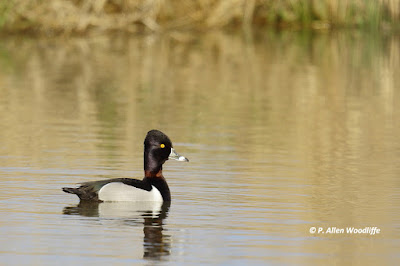But the last day or so was a great change of scenery and included several of my 'go-to' places in Chatham-Kent.
Rondeau Prov Park is always worthwhile, for many reasons. It was a relatively quiet, windless morning, so I stopped first at the Spicebush Trail hoping that the Louisiana Waterthrush which has been noted there on occasion would make an appearance. Not today.
The South Point Trail is usually a good place to meander along. Eastern Towhees are regular.
There has been an influx of White-throated Sparrows in the last couple of days. In places, the ground seems to be moving as they shuffle through the leaves searching for food.
A large number of Chipping Sparrows were in the sandy beach dunes at the forest edge. I scanned through as many as I could, hoping that a Lark Sparrow as was found at Point Pelee a couple of days ago, might be mixed in with this group, but it was not to be.
I got my first of year (FOY) Pine Warbler, and one of the two I saw even allowed me to get at least a record shot as it came down to a leafless branch. When they are flitting through the pines, it isn't quite so easy.
 |
| Pine Warbler not in a pine |
 |
| Woodpecker in the willow |
I had tried to get a photo of Northern Flicker from time to time, and I often find that if you move in their direction, they quickly move on. But while waiting near the willow tree that the Red-headed Woodpecker was supposed to come to, I noted this flicker arrive and start feeding on the lawn, apparently not concerned about my presence.
A short while later, I checked up on another red, white and black bird, the reported Rose-breasted Grosbeak, and found it coming to a feeder just north of the Visitor Centre.
The White-winged Dove continues at its alternate site, trying to build a nest on top of a stove pipe. I'm not sure what goes through its head when the material it keeps depositing on this slippery and shiny surface disappears almost as fast as it is deposited.
Another member of the dove family, Mourning Dove is, at this point, having more success than the White-wing. This nest was in a honeysuckle bush along the Tuliptree Trail.
I stopped at the Spicebush Trail again, just in case the Louisiana Waterthrush was in the area. Still no waterthrush, but the highlight was to have a visit with Rob and Pauline, two former MNR colleagues whom I hadn't seen in many years.
Before leaving the park, I checked out the maintenance loop. No new birds for the day, but I got my FOY Question Mark.
The species is not common in April but does occur in very low numbers. The dark upper hind wing indicates it is a summer form, which is apparently typical of spring migrants.
A brief swing by Erieau had distant waterfowl and a few Caspian Terns.
Yesterday afternoon, we went to the Mitchell's Bay area, exploring both the south shore trail and north shore trail. I noted a sub adult Glaucous Gull and a Common Gallinule, both FOY but no photos. There were some cooperative Forster's Terns.
The Purple Martin houses have attracted the target species.
An American Coot was close by the north shore trail......
....as was a Ring-necked Duck.
The target species I was hoping for was Yellow-headed Blackbird. I had intended to go out on Friday afternoon, since it had been a few days since my previous visit, but some other projects kept me away. Later that evening I noted that Blake had seen about 7 males, so I figured my chances were good on this day. Sure enough, three were seen foraging on a lawn near the south trail, while at least another four were hanging out with a large mixed flock of blackbird types in the field to the east of the trail. I didn't see any females, but they should arrive soon and let the nesting begin!



















Hard to believe that many Red-headed Woodpeckers were around on that CBC! They are certainly difficult to find anymore throughout the countryside.
ReplyDeleteIndeed. RHWO were always relatively common back in the day (1960s and 1970s) and things like Red-bellied Woodpeckers were really rare. And Yellow Warbler was a candidate 'Blue List' species according to the National Audubon Society. Blue List species were ones that were in serious decline, and were considered as needing special protection. Of course nowadays, YEWA is by far the most common breeding warbler in southern Ontario and many other places. How times have changed through the ebb and flow of the natural world!
Delete